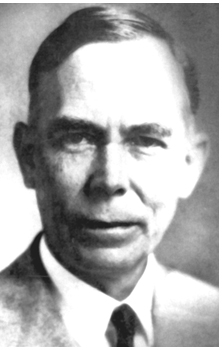
James Arthur “J. A.” Griffin (1874-1958)
Inducted 1962
Highlights
Board of Exchange Bank of Tampa
Mediterranean Fruit Fly
Board of Exchange National Bank of Winter Haven
Florida Bankers Association
Tampa Investment & Securities Company
Florida Bankers’ Association
Elfers Citrus Growers Association
Florida Citrus Mutual
Florida Citrus Exchange
Florida State Fair
Bio
James Arthur Griffin, citrus grower, horticulturalist, civic leader, and influential banker, is remembered as one of the most foresighted leaders of the citrus industry. His vital efforts paved the way for commercial banks to play an active role in citrus development in the Twentieth Century.
James was born in the small town of Fulton, Georgia, in 1874. His family then moved to Marion County, Florida, where he attended school and began his career in the banking industry as a clerk in Ocala. In 1895 his family moved to Tampa, and Griffin accepted a position as clerk at the Board of Exchange Bank of Tampa. Highly motivated, especially after marrying Nannie Marshal Johnson in 1902, Griffin rose to the position of cashier and then director by 1903. By 1920, he was serving as the vice president of the institution, and was then president two years later, a position he maintained for the remainder of his life.
As a banker he continued to rise in prominence, but this was largely because he was also a citrus grower. The first-hand knowledge he gained over the years in his orchards gave him the ability to offer careful insight and sound advice to investors and farmers alike which in turn helped the citrus industry develop tremendously. Griffin was a member of several committees and studies, whose goals and research aimed at positively developing the industry. Griffin acted as citrus industry and growers spokesperson in an attempt to obtain federal aid to combat the Mediterranean Fruit Fly in 1929-31.
As a successful and motivated banker and grower, Griffin helped bridge the gaps between the citrus industry and financial institutions greatly. In addition to serving as chairman and president of the Board of Exchange Bank of Tampa, he was the Chairman of the Board of Exchange National Bank of Winter Haven. He served as the director and president of the Tampa Investment and Securities Company, and was also a past president of the Florida Bankers’ Association. He gained further understanding of what farmers and the industry as a whole needed by staying actively involved in broader organizations like the Florida State Horticulture, as well as local societies such as the Elfers Citrus Growers Association which he helped organize. From these positions he had the knowledge and resources to wisely initiate policies that helped local farmers secure loans and citrus industry entrepreneurs construct new packing houses and marketing strategies.
In the late 1940s, the citrus industry experienced heavy market fluctuations, which jeopardized the average grower’s ability to cover the cost of production. For this reason he and a group of like-minded men dedicated themselves to stabilizing prices through the creation and development of an independent bank for citrus farmers called Florida Citrus Mutual Bank which officially opened in 1949. Griffin also promoted the citrus industry’s financing through his leadership role in the Florida Citrus Exchange, and helped with marketing efforts as a leader of the Florida State Fair.
Having profited greatly from the citrus industry, Griffin was certainly not slow to give back to the community. In 1919, he was awarded a Silver Trophy for outstanding record of sales in a Victory War bond selling campaign which he headed in the area. He made numerous contributions to local medicine by promoting and funding modern surgical equipment. He was also a director of the local Children’s Home. He worked alongside the local Community Chest, and was a charter member of the Tampa Rotary Club. His efforts did not go un-recognized by the public. Tampa University made him an honorary trustee, the Tampa Civitan Club voted him Outstanding citizen of the Year in 1947, and in 1962 he was among the first group of inductees of the new Florida Citrus Hall of Fame.
